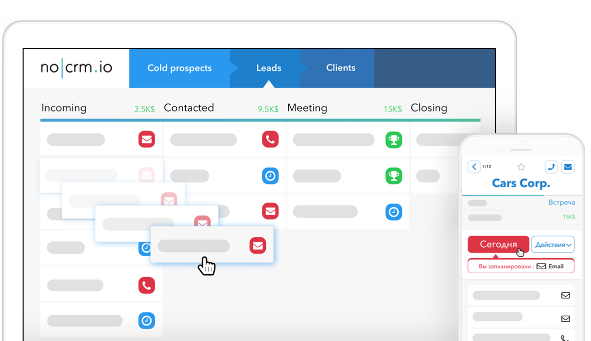The time has come to stop wasting time and effort on prospecting without a plan. If you haven’t established a clear strategy and performance indicators, you will quickly lose motivation in achieving your sales goals. Read on to discover the key steps to establish a successful B2B prospect management plan for your business.

Contents
- 📌 Key Points
- What is B2B Prospect Management?
- How to effectively execute B2B prospect management
- Define the key objectives of your prospect management plan
- Define the target audience of your prospect management plan
- Define a budget for your prospect management efforts
- A plan to accelerate your B2B Sales
- FAQ
📌 Key Points
- A prospect management plan helps organize, execute, and measure your sales prospecting efforts.
- The plan should define goals, audience, tools, budget, and key acquisition channels.
- Techniques such as email campaigns, cold calling, and sponsorships work best when targeted to your Ideal Customer Profile (ICP).
- Reviewing current customers and market segments helps expand reach without starting from scratch.
- Using a lead management tool like noCRM makes implementation more efficient and effective.
What is B2B Prospect Management?
B2B prospect management is the process of identifying potential prospects, managing them, and converting them into customers. A prospect management plan comes into motion when:
A lead is captured and assigned to a sales rep and they start treating them.
A well-defined prospect management plan helps you develop a framework in order to reach the sales objectives you’ve set.
Your plan should define concrete sales actions by identifying the best acquisition channels and techniques for your business, such as
Emailing campaigns
Telephone prospecting
Sponsorship program
This will enable you to prioritize tasks and accelerate your prospecting process while achieving your sales goals.
How to effectively execute B2B prospect management
Your BtoB prospect management plan should contain the following key criteria in order to be effective:
- The sales objectives (volume or turnover) that you wish to achieve, for a given period.
- A precise definition of your target audience: who are the prospects you are targeting? What are their needs and challenges? What are their characteristics? Where do you expect to find them?
- The key tools and channels you want to use reach your prospects.
- The budget you have available to invest in tools, trade shows, PR communication etc.
Creating a foolproof B2B prospect management plan avoids wasting time and energy in your prospecting efforts. It ensure there no leakages and, above all, it acts as a guideline. This allows you to remain 100% focused on your objectives on a daily basis.
Define the key objectives of your prospect management plan
Your objectives should include both quantitative and qualitative goals.
- Quantitative goals might include revenue targets, number of calls or emails, or conversion rates.
- Qualitative goals focus on customer loyalty, brand perception, or improving your overall image in the market.
Set SMART goals (Specific, Measurable, Achievable, Relevant, and Time-bound) to guide your daily efforts and team alignment.
Increase B2B Sales Turnover
To increase your company’s turnover you can consider two different solutions – Increase your Sales or Increase the Number of Customers.
1. Increase Sales to Existing Customers (Upselling & Cross-Selling)
Focus on selling additional products or services to your current clients. This strategy:
- Increases average order value
- Deepens customer relationships
- Is generally more cost-effective than new customer acquisition
2. Acquire New Customers
Target new prospects by:
- Researching and defining ideal leads
- Gathering accurate contact data
- Using tools and channels to generate demand and fill your pipeline
Both paths can work in tandem, depending on your capacity and goals.
Review your Existing Customer Base
Your customer database is very valuable! Winning new customers requires many more resources from a company compared to capitalizing on your existing customers.
You must therefore work this base in order to be able to continue to sell to people already convinced by your products/services and take care of them because your customers are also your best ambassadors.
Pamper them and communicate regularly to stay close to them. You could also ask their opinion and measure their satisfaction levels to make them feel important to your business.
To do so, there are several techniques to build customer loyalty over time:
- Develop a Long-Lasting Relationship by keeping in touch with your customers and letting them know about various offers. A long-lasting relationship with a customer could earn you a referral.
- Create Value for your Customers by giving them an upgrade. Giving active customers who engage with your product or service on a regular basis something they weren’t expecting is always a step in the right direction.
- Reconnect with Inactive Customers through commercial reactivation techniques such as: promoting new features, participation in events, webinars, special offers, etc.
Expand your customer portfolio by prospecting in new markets
Want to launch your business in a new region or a new country? If you’re looking to develop your business in a new market, add geographical area/location as part of your prospecting plan.
Target prospects by:
- Industry
- Company size
- Revenue
- Existing tools used
- Competitors
You will be able to use these criteria to find events to attend, search for connections on your professional social networks but also to build and/or purchase databases in order to get more prospects and meetings. This research could also help you understand how feasible it will be to launch your business in the new market – are there enough prospects to make it worthwhile?
Do not lose hot leads / opportunities / deals
Once a prospect has shown interest in your company, you’ve already done most of the work! Now it’s time to ensure that you maximize your chances of signing and turning your prospect into a customer.
Prepare for Meetings
- Research your lead’s company and challenges
- Identify if they’re the decision-maker
- Understand negotiation boundaries
During the Meeting
- Listen actively and ask discovery questions
- Tailor your pitch to their exact pain points
- Always define the next step: send a proposal, schedule another meeting, etc.
Train Your Team
- Regularly coach your sales reps on product knowledge and sales tactics
- Shadow meetings and offer feedback
Offer a Free Trial
- Let prospects experience your product before they commit—especially effective in SaaS.
Use Testimonials and Case Studies
- Showcase relevant success stories to build credibility and shorten the decision cycle.
Define the target audience of your prospect management plan
Clearly determining your target audience is an essential step in business prospecting. The more you research your target audience and understand their needs, the more efficient you will be in your prospect management.
Persona and Ideal Customer Profile
Your ICP (Ideal Customer Profile) and/or Personas should be detailed enough that you have a clear idea of the needs and the expectations of your target audience.
In theory, once your target has been established, it is important that you segment your database in order to prioritize prospects on whom you want to focus. Establishing your target audience is a key element of the prospect management plan, it will help you in choosing the right channel to communicate with them, and also help nurture prospects with customized personal messages.
To be 100% effective, it is important to remember that a target audience is accurate, is accessible, and profitable.
Define a budget for your prospect management efforts
The budget for your prospect management strategy must cover all your prospecting costs. It must take into account your investment in a lead management software as well as the costs related to your sales reps’ actions such as: email, telephone, travel, etc.

Invest in a lead management software
Excel files, notes, and other manually kept records have long been sufficient for small businesses, however, they are neither time-saving nor scalable solutions if your business grows.
CRM solutions such as Salesforce, and Microsoft Dynamics, may look attractive too because they’re reliable and globally recognized. However, these CRM solutions require not only a big financial investment and commitment on the part of your company, but also a human investment to train your teams to use these complex solutions.
Rather than spending a fortune on such solutions that will be of little or no use to your sales teams and sales reps, it is more relevant to invest in a simpler and equally effective SaaS solution at a lower cost.
The noCRM.io solution is a software specifically designed for salespeople to track and close sales without wasting time. You can start a 15 day free trial with no credit card or commitment.
The budget allocated to prospect management techniques/tools
A lot of tools and techniques go into making prospect management a success. Obviously, these tools and techniques cost businesses something. The techniques we detail here, sometimes require the purchase of online tools or a material investment. It is important that you budget for them in advance so that as a business you invest in tools that work best for your prospect management plan
When drawing up your budget to carry out prospect management, you must take into account the potential investments generated by the tools and techniques you invest in.
A plan to accelerate your B2B Sales
A well-organized prospect management plan is essential to increase and accelerate your sales. Without a clearly defined and documented framework, you are moving forward blindly and it is difficult to measure your performance.
By combining structured planning with agile tools like noCRM, you can create a sustainable, scalable sales system that continuously improves—and you can try it risk-free with a 14-day free trial, no credit card required.
FAQ
A B2B prospect management plan is the entire process that consists in identifying prospects, managing them and converting them into clients.
The objectives of your B2B prospect management can be quantitative or qualitative.
Defining your target audience is an essential step of sales prospecting. The more research you do about your target audience, the more you’ll understand its needs and how you can meet them. This leads to better prospect management.


